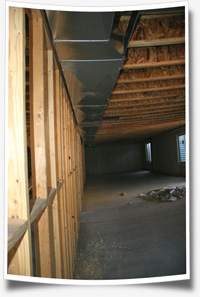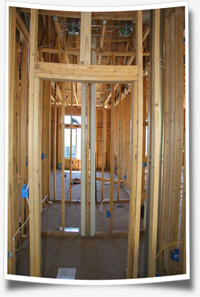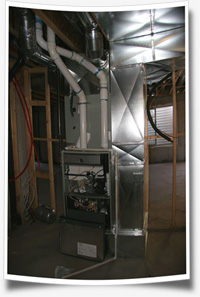Heating, Ventalation & Air Conditioning
The HVAC rough-in moved very quickly, however, there was a lot of work to do. Four or five guys worked three solid days to complete the rough-in. The rough-in stage consisted of running all of the air supply lines, cold air returns, installing the furnace, and running the gas lines to the various areas of the house (laundry, kitchen, mechanical room, barbeque, fireplace, etc.) They also installed the fireplaces (our fireplaces are direct vent natural gas units, more on the fireplaces in a separate topic).
I had assumed that the plumber would install the gas lines, in our case the HVAC contractor took care of this. Apparently it depends on the contractor, sometimes the plumber will do this, other times the HVAC contractor will install the gas lines.
I was up at the site quite a bit during the HVAC rough-in which turned out to be quite helpful. They asked me my opinion on several items which allowed me to customize things to my preferences. Although not a big deal, it was nice to be able to decide where to place the supply lines (considering where furniture would be placed), the location of the thermostats, etc.
I was also able to discuss with them the placement of the cold air return lines in the basement, particularly important to me since I will be finishing off the basement soon after we complete the house. The spot they originally chose would not have been very good at all - it would have gone right down the middle of a future hallway, effectively dropping the ceiling height nearly a foot. Instead, we worked out a different spot that was mostly through the end of a bedroom where a closet will be, making the cold air return virtually out of site and out of the way. It was very helpful to spend time with the HVAC crew instead of having them try to guess what would work best.
The HVAC installation produced a few problems that we had to work through. For example, the house plans showed a nice little niche where the flue for the water heaters was supposed to run. However, after the house was framed, we looked at the spot and immediately could tell that there was no way the flue could actually run up through that spot (one of those things that works out on paper but not in construction).
As a result, we had to pick a different spot to run the flue which was a bit of a challenge. Obviously any spot we chose would eat up living space; we ended up choosing a corner of the pantry which proved to only be a minor sacrifice. We were lucky I suppose - the HVAC contractor told me about a time when the only option they had was to go right up through the middle of a customer's pantry which effectively turned the pantry into an over-sized spice rack.
The HVAC contractor offered us a variety of options & upgrades for the equipment he installed. The bid allowed for an 80% efficient furnace and a 10 SEER air conditioning unit, both of which are considered "builder's grade", i.e. the low cost options. I did a bit of research and found out the beginning next year, the lowest SEER rating that will be permitted to be manufactured will be 13 (in the case of a SEER rating, the higher the number the more efficient the unit). As a result, I decided to upgrade our AC unit to a 13 SEER model. We also decided to upgrade the furnace to a 90% efficient unit - although the payback in energy savings won't be for several years, I think it is a good investment considering that the winters in our area can be quite cold.
The furnace unit requires a direct vent installation, which means there are completely sealed intake and exhaust PVC pipes that hook directly up to the furnace and run all the way up and out of the roof. Some furnaces only require general combustion air (i.e. a large pipe that allows fresh air into the mechanical room, apparently the more efficient models require direct venting. Running these pipes required quite a bit of labor, which is part of the reason upgrading to a more efficient unit was a significant cost (approximately $900).



